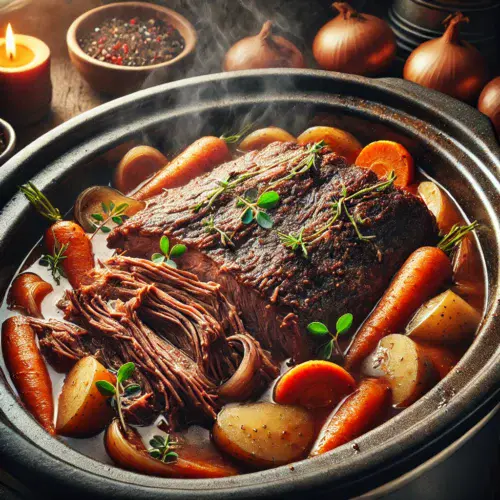
Tender, flavorful meat is the hallmark of a well-prepared dish. Whether you’re preparing a simple weeknight dinner or an elaborate feast, understanding how to make meat more tender is essential for achieving the best results. Fortunately, tenderizing meat doesn’t require advanced culinary skills. With the right techniques and a little time, even the toughest cuts of meat can be transformed into melt-in-your-mouth perfection.
This guide will explore expert techniques for tenderizing meat, from acid-based marinades to slow-cooking methods. We’ll also provide insights into common mistakes that lead to tough meat and how to avoid them. Let’s dive into how to make meat more tender and flavorful.
1. Use Acid-Based Marinades
An acid-based marinade is one of the most popular and effective ways to tenderize meat. The acidity in ingredients such as vinegar, lemon juice, wine, or yogurt helps break down tough muscle fibers, making the meat softer and easier to chew.
How Acid Works:
When meat is exposed to acidic ingredients, the acids denature (or unravel) the proteins in the muscle fibers, weakening the meat’s structure and making it more tender. In addition to enhancing tenderness, marinades can also infuse the meat with additional flavors, making your dishes more robust.
Best Ingredients for Acid-Based Marinades:
- Lemon juice: Perfect for poultry and fish.
- Vinegar: Works well with beef and pork.
- Yogurt: Often used in Mediterranean and Middle Eastern dishes, it adds a tangy flavor while tenderizing the meat.
- Wine: Adds a depth of flavor, commonly used in sauces and stews.
Pro Tips:
- Time: For best results, marinate meat for at least a few hours or overnight if possible.
- Balance: Include fat (like olive oil) in your marinade to balance the acidity and prevent the meat from becoming too mushy.
- Herbs & Spices: Enhance your marinade with herbs, garlic, or spices to add flavor and tenderness.
Example:
For chicken breasts, try marinating them in lemon juice, olive oil, garlic, and herbs for 4-6 hours. This will result in flavorful, tender chicken, perfect for grilling or roasting.
2. Slow-cooking for Tenderness
Another powerful technique for making meat more tender is slow cooking. When meat is cooked at a low temperature for an extended period, the collagen in the connective tissues breaks into gelatin, resulting in tender, juicy meat. This method is especially useful for tougher cuts of meat like brisket and short ribs.
Why It Works:
Collagen, a tough protein found in meat, begins to break down when cooked slowly at low temperatures. As it turns into gelatin, it adds moisture and richness to the meat, enhancing its tenderness and flavor. Slow cooking also helps retain the meat’s natural juices, preventing it from drying.
Methods of Slow-Cooking:
- Slow Cooker (Crockpot): This is ideal for hands-off cooking. Simply add your meat and ingredients, set the temperature, and let it cook for 6–8 hours.
- Braising involves searing the meat at a high temperature and simmering it slowly in a liquid (like broth or wine) in a covered pot.
- Oven: Set your oven to a low temperature (around 275°F to 300°F) and cook the meat for several hours.
Pro Tips:
- Liquid: When slow-cooking, always include a liquid component (broth, wine, or water) to prevent the meat from drying.
- Seasoning: Slow cooking allows spices and herbs to permeate the meat, so be generous with your seasoning.
- Patience: Don’t rush the process. Letting the meat cook slowly over time is key to achieving that fall-apart tenderness.
Example:
For a tender beef brisket, sear the meat on both sides, then braise it in beef broth and red wine in a Dutch oven at 300°F for 6–8 hours.
3. Mechanical Tenderization: Pounding and Scoring
Mechanical tenderization involves physically breaking down the muscle fibers in meat, making it more tender. This can be done by pounding the meat with a mallet or scoring its surface with a knife.
Pounding:
Pounding meat with a mallet flattens it and breaks down the muscle fibers, which helps the meat cook more evenly and become tender. This technique is particularly useful for thinner cuts of meat like chicken breasts or pork chops.
Scoring:
Scoring meat involves making shallow cuts across its surface, which helps the meat absorb marinades more effectively and can aid in tenderization.
Pro Tips:
- Use a Meat Mallet: A meat mallet with a flat or spiked side is ideal for pounding tougher cuts of meat.
- Gentle Scoring: When scoring, be careful not to cut too deeply, as this can cause the meat to fall apart during cooking.
- Even Thickness: Pounding the meat to an even thickness ensures it cooks uniformly, preventing some areas from drying.
Example:
For veal cutlets, lightly pound the meat with a mallet, then marinate and grill or pan-sear for a tender, juicy meal.
4. Use Salt to Tenderize Meat
Salt is a natural tenderizer that can enhance meat tenderness in various ways. Salt draws out moisture from the meat’s surface, which may sound counterproductive, but it actually allows the salt to penetrate the meat. This process breaks down muscle proteins, resulting in a more tender texture.
How to Salt Meat:
- Dry Brining: Generously coat the meat with salt and let it rest in the refrigerator for 30 minutes to several hours. This technique is particularly useful for steaks, pork chops, and whole chickens.
- Wet brining involves submerging the meat in a salty water solution, which helps the meat retain moisture and become more tender during cooking.
Pro Tips:
- Timing: Salt the meat at least 30 minutes before cooking, but for larger cuts, such as whole chickens or roasts, allow the salt to sit for several hours or overnight.
- Rinse Before Cooking: After salting, rinse the meat to remove excess salt and pat it dry before cooking.
- Salt Evenly: Make sure to salt evenly on all sides for consistent results.
Example:
Rub both sides with kosher salt for a tender steak and let it rest for 30 minutes before grilling. The result will be a juicy, well-seasoned steak with a perfect sear.
5. Cooking at the Right Temperature
Cooking meat at the proper temperature is critical for tenderness. High heat often produces tough, dry meat, particularly with larger cuts. Instead, simmering meat at lower temperatures ensures even cooking and allows the meat’s collagen to break down.
Ideal Cooking Temperatures:
- Steak: Aim for an internal temperature of 135°F for medium-rare or 145°F for medium doneness.
- Poultry: Cook chicken to an internal temperature of 165°F.
- Pork: Pork should reach an internal temperature of 145°F with a 3-minute rest time.
Use a Meat Thermometer:
Invest in a good meat thermometer to achieve the perfect tenderness without overcooking. By monitoring the internal temperature, you can avoid the common mistake of cooking meat too long or too short.
Pro Tips:
- Low and Slow: For tougher cuts like brisket or ribs, cook slowly at low temperatures for extended periods to break down connective tissues.
- Resting: Always allow your meat to rest after cooking to help redistribute the juices.
6. Resting the Meat
Resting meat after cooking is one of the simplest yet most effective techniques for improving tenderness. After the meat is cooked, the muscle fibers are still contracted. Allowing the meat to rest gives the fibers time to relax, allowing the juices to redistribute evenly throughout the meat.
Why Resting is Important:
Cutting into the meat right after cooking can cause the juices to spill, leaving the meat dry and less flavorful. Resting the meat for 5–10 minutes for small cuts or up to 20 minutes for larger roasts ensures the juices stay inside, making the meat juicier and more tender.
How to Rest Meat:
- Remove the meat from the heat and place it on a plate or cutting board.
- Cover the meat loosely with aluminum foil to keep it warm as it rests.
- Rest for 5–10 minutes for steaks or chops and up to 20 minutes for larger cuts like roasts.
Pro Tips:
- Patience is Key: Resist the urge to cut into the meat immediately after cooking.
- Rest Before Slicing: Always rest your meat before slicing to ensure maximum tenderness and juiciness.
Common Mistakes to Avoid When Tenderizing Meat
Even with the best tenderizing methods, certain mistakes can still lead to tough, dry meat. Here’s what to avoid:
- Overcooking: Cooking meat at too high a temperature or too long can produce a tough, chewy texture.
- Not Marinating Long Enough: While marinades can work quickly, allowing your meat to marinate for at least a few hours (or overnight) will yield the best results.
- Skipping the Rest Period: Skipping the resting period can lead to a dry, less tender final product.
- Improper Use of Tenderizers: Mechanical tenderizers should be used carefully—too much force can tear the meat and ruin its texture.
Conclusion: Transforming Tough Cuts into Tender Delights
With the right techniques, perfectly tender meat is possible. From using acid-based marinades to employing slow-cooking methods and giving your meat ample time to rest, these expert methods can transform even the toughest cuts into mouthwatering meals. By avoiding common mistakes and mastering the art of meat tenderization, you’ll elevate your cooking game and impress your guests with tender, delicious dishes.
For more detailed tips and storage solutions, check out the link
Whether you’re preparing a slow-cooked brisket, marinated chicken, or a perfectly grilled steak, these techniques will ensure that your meat is tender, flavorful, and juicy every time. Happy cooking!
How to Make Meat More Tender: Expert Techniques
Instructions
1. Use Acid-Based Marinades
Ingredients such as vinegar, lemon juice, or yogurt, with their acidity, help soften tough meat fibers, enhancing tenderness.. The acidity denatures proteins, which softens the meat’s structure. Allow your meat to marinate for a few hours or overnight for the best results.
2. Slow-Cooking
Slow-cooking meat at low temperatures for an extended period helps break down connective tissues and tough fibers, resulting in melt-in-your-mouth tenderness. This method works particularly well for tougher cuts of meat like brisket or short ribs. Utilize a slow cooker or braise the meat in the oven for optimal tenderness.
Pounding the meat with a mallet or using a meat tenderizer breaks down muscle fibers, making it softer. You can also score the meat by making shallow cuts across its surface, which helps it absorb marinades better.
3. Mechanical Tenderization
4. Use Salt
Salt naturally tenderizes meat by drawing out moisture and breaking down proteins. Generously salt the meat at least 30 minutes before cooking to allow it to penetrate the surface.
5. Cooking at the Right Temperature
Cooking meat at excessively high temperatures can result in toughness. Keep the heat low and steady, especially for larger cuts, to ensure that the meat cooks evenly without drying out. Use a meat thermometer to monitor internal temperatures.
6. Resting the Meat
Allowing meat to rest after cooking redistributes the juices, keeping it moist and tender. Resting also allows the fibers to relax, resulting in a more enjoyable texture.
Notes
By incorporating these methods into your cooking, you can transform even the most brutal cuts of meat into tender, flavorful meals. Whether you marinate, slow-cooking, or salt your meat beforehand, mastering these techniques will enhance your cooking and impress your guests with tender, delicious dishes.




